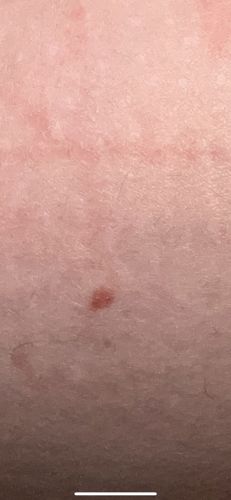Unknown (potential tick bite/skin irritation)
Scientific Name: Undeterminable from the image; if a tick, it depends on the species (e.g., Ixodes scapularis for blacklegged tick, Amblyomma americanum for Lone Star tick).
Order & Family: If this is a tick, it belongs to the Order Ixodida (ticks), and Family is either Ixodidae (hard ticks) or Argasidae (soft ticks). Without a clear image of the arthropod itself, identification is difficult. The image only shows a mark on the skin.
Size: If this is a tick, nymphs (which are often responsible for bites) can be less than 1 mm, while adult ticks range from 2 mm to 10 mm (when engorged).

Natural Habitat
If this is a tick, their habitat typically includes wooded areas, tall grasses, brush, and leaf litter. They wait on vegetation for hosts to pass by.
Diet & Feeding
If this mark is from a tick, then their diet consists solely of blood from mammals, birds, and reptiles. They are obligate hematophagous ectoparasites.
Behavior Patterns
The image shows a small red mark on human skin, which is often characteristic of a bite or skin irritation rather than an insect itself. If this is an insect, it could be a tick. Ticks are not insects but arachnids. They cling to hosts for blood meals, which can last for several days. They are slow-moving and remain attached until engorged or removed. Their life cycle involves four stages: egg, larva, nymph, and adult, with blood meals required at each active stage.
Risks & Benefits
If this mark is a tick bite, the primary risk is the transmission of various pathogens, leading to diseases such as Lyme disease, Rocky Mountain spotted fever, anaplasmosis, ehrlichiosis, and others. Tick bites can also cause localized skin irritation, redness, and swelling. There are no direct benefits to humans from ticks; they are considered parasites. In the ecosystem, they are part of the food chain for some animals, but their impact is generally negligible compared to their role as disease vectors.
Identified on: 9/4/2025